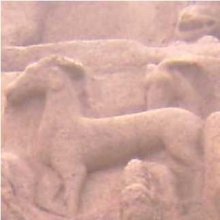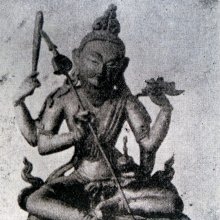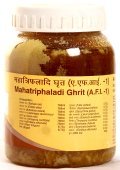Goat: 2 definitions
Introduction:
Goat means something in Buddhism, Pali, Hinduism, Sanskrit. If you want to know the exact meaning, history, etymology or English translation of this term then check out the descriptions on this page. Add your comment or reference to a book if you want to contribute to this summary article.
Images (photo gallery)
In Hinduism
Yoga (school of philosophy)
Source: ORA: Amanaska (king of all yogas): A Critical Edition and Annotated Translation by Jason BirchGoats are denoted by the Sanskrit term Chāga, according to the Amanaska Yoga treatise dealing with meditation, absorption, yogic powers and liberation.—Accordingly, as Īśvara says to Vāmadeva: “[...] Not knowing the highest reality, which is situated within himself, the confused man goes astray [looking for it] in the scriptures, [just as] the foolish herdsman looks in a well while the [missing] goat (chāga) is [being held] under his armpit. [...]”.

Yoga is originally considered a branch of Hindu philosophy (astika), but both ancient and modern Yoga combine the physical, mental and spiritual. Yoga teaches various physical techniques also known as āsanas (postures), used for various purposes (eg., meditation, contemplation, relaxation).
In Buddhism
Tibetan Buddhism (Vajrayana or tantric Buddhism)
Source: academia.edu: The Structure and Meanings of the Heruka MaṇḍalaThe Goat is associated with the Yoginī (female deity) named Ajakī, being situated in the Medinīcakra, according to the 10th century Ḍākārṇava-tantra: one of the last Tibetan Tantric scriptures belonging to the Buddhist Saṃvara tradition consisting of 51 chapters.—Accordingly, the medinīcakra refers to one of the three divisions of the dharma-puṭa (‘dharma layer’), situated in the Herukamaṇḍala. The 36 pairs of Ḍākinīs [viz., Ajakī] and Vīras are yellow in color; the shapes of their faces are in accordance with their names [e.g., Goat]; they have four arms; they hold a skull bowl, a skull staff, a small drum, and a knife.

Tibetan Buddhism includes schools such as Nyingma, Kadampa, Kagyu and Gelug. Their primary canon of literature is divided in two broad categories: The Kangyur, which consists of Buddha’s words, and the Tengyur, which includes commentaries from various sources. Esotericism and tantra techniques (vajrayāna) are collected indepently.
See also (Relevant definitions)
Starts with: Goat apple, Goat bitter apple, Goat head, Goat milk, Goat pea, Goat skin, Goat weed, Goat willow, Goat-heads, Goat-killer, Goat-pimpler, Goatgrass, Goatsbeard, Goatweed, Goatwood.
Ends with: Goat milk, Gogoat, Ram goat.
Full-text (+921): Aja, Chaga, Ajaka, Ajajiva, Basta, Vasta, Chagala, Ajajivika, Edaka, Ajavika, Parnabhojana, Menada, Bukka, Varkara, Lambakarna, Bakara, Sarvabhaksha, Manja, Ajamayu, Ajagalastana.
Relevant text
Search found 207 books and stories containing Goat; (plurals include: Goats). You can also click to the full overview containing English textual excerpts. Below are direct links for the most relevant articles:
The Jataka tales [English], Volume 1-6 (by Robert Chalmers)
Jataka 426: Dīpi-jātaka < [Volume 3]
Jataka 437: Pūtimaṅsa-jātaka < [Volume 3]
Jataka 386: Kharaputta-jātaka < [Volume 3]
Folklore of the Santal Parganas
Chapter CXXXVII - The Thief’s Son < [Part III]
Chapter 4 - The Jackal and His Neighbours < [Appendix]
Chapter XXXIX - The Daydreamer < [Part I]
Bhagavad-gita-mahatmya (by Shankaracharya)
Brihat Samhita (by N. Chidambaram Iyer)
Chapter 65 - On the features of the Goat (chāga-lakṣaṇa)
Chapter 76 - Erotic remedies, Spermatic drugs and Medicines (kāndarpika)
The Bhagavata Purana (by G. V. Tagare)
Chapter 19 - Yayāti’s Retirement and Final Emancipation < [Book 9 - Ninth Skandha]
Chapter 19 - Swallowing up of a Forest-conflagration < [Book 10 - Tenth Skandha]
Chapter 15 - Birth of Pṛthu and his Coronation < [Book 4 - Fourth Skandha]
Manusmriti with the Commentary of Medhatithi (by Ganganatha Jha)
Verse 8.235 < [Section XXXIX - Disputes between Owner and Keeper]
Verse 8.241 < [Section XXXIX - Disputes between Owner and Keeper]
Verse 5.128 < [Section XIII - Purification of Substances]
Related products
(+7 more products available)







